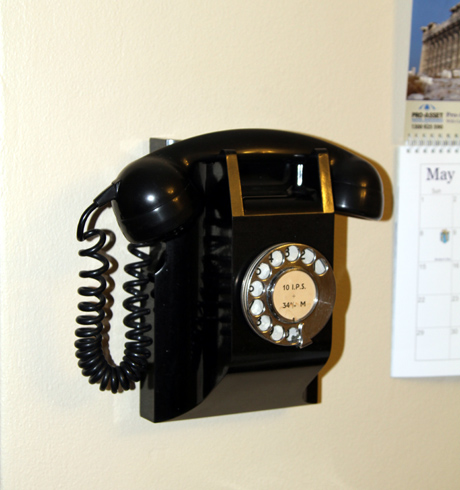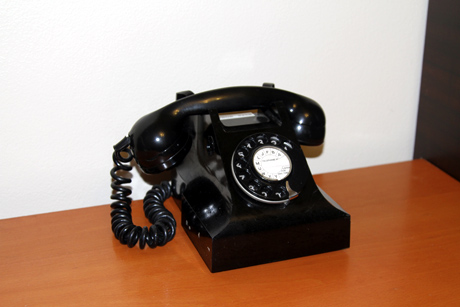Vintage Telephones
Forum home - Go back to Vintage Telephones
|
Black Beauty
|
|
|
Return to top of page · Post #: 1 · Written at 9:55:47 PM on 8 May 2011.
|
|
|
|
Administrator
Location: Naremburn, NSW
Member since 15 November 2005 Member #: 1 Postcount: 7588 |
|
It is a case of function over form - the two telephones that serve me well and should live on after the introduction of the national FTTH communications network known as the NBN thanks to a device that converts decadic pulses to DTMF tones that will be recognised by the next generation of telephone exchanges.  This wall phone is in my kitchen and is connected to the second phone line, which I use mainly for receiving calls and Internet usage. That phone line also feeds the web server that hosts Vintage Radio and Television.  The table phone above is in the lounge room next to my Airzone console radio. It is the phone I make most calls on, not that I make many these days. It is a testament to backwards-compatibility that modern digital telephone exchanges still support decadic (pulse) dialling, which is required for these phones to work correctly. These telephones were made by Amalgamated Wireless Australasia (AWA) but also made by Standard Telephones and Cables (STC). ‾‾‾‾‾‾‾‾‾‾‾‾‾‾‾‾‾‾‾‾‾‾‾‾‾‾‾‾‾‾‾‾‾‾‾‾‾‾‾‾‾‾‾‾‾‾‾‾‾‾‾‾‾‾‾‾‾‾‾‾‾‾‾‾‾‾‾‾ A valve a day keeps the transistor away... |
|
|
Return to top of page · Post #: 2 · Written at 10:00:59 AM on 15 July 2011.
|
|
|
|
Location: Blue Mountains, NSW
Member since 30 June 2011 Member #: 944 Postcount: 30 |
|
The dial on your 400AW wall phone has been specially calibrated, given what's on the label. It makes me think this phone has been used for exchange testing. Or the dial has been retrieved from something that was. |
|
|
Return to top of page · Post #: 3 · Written at 10:28:44 PM on 15 July 2011.
|
|
|
|
Administrator
Location: Naremburn, NSW
Member since 15 November 2005 Member #: 1 Postcount: 7588 |
|
Good point with the letters. I gathered for a second that 27-6379 was the phone number for the local shimmy palace. ‾‾‾‾‾‾‾‾‾‾‾‾‾‾‾‾‾‾‾‾‾‾‾‾‾‾‾‾‾‾‾‾‾‾‾‾‾‾‾‾‾‾‾‾‾‾‾‾‾‾‾‾‾‾‾‾‾‾‾‾‾‾‾‾‾‾‾‾ A valve a day keeps the transistor away... |
|
|
Return to top of page · Post #: 4 · Written at 1:01:11 PM on 24 July 2011.
|
|
|
|
Location: Sydney, NSW
Member since 9 July 2011 Member #: 955 Postcount: 36 |
|
Hi Brad |
|
|
Return to top of page · Post #: 5 · Written at 5:28:13 PM on 24 July 2011.
|
|
|
|
Administrator
Location: Naremburn, NSW
Member since 15 November 2005 Member #: 1 Postcount: 7588 |
|
It makes me wonder if AWA and STC manufactured any phone cabinets in odd colours on an experimental basis. I've seen black, ivory, red and green though the latter three colours were on phones made much later than those I have (I'm not sure of model numbers or any similar details) and if such cabinets were made then have they survived somewhere. ‾‾‾‾‾‾‾‾‾‾‾‾‾‾‾‾‾‾‾‾‾‾‾‾‾‾‾‾‾‾‾‾‾‾‾‾‾‾‾‾‾‾‾‾‾‾‾‾‾‾‾‾‾‾‾‾‾‾‾‾‾‾‾‾‾‾‾‾ A valve a day keeps the transistor away... |
|
|
Return to top of page · Post #: 6 · Written at 6:07:31 PM on 24 July 2011.
|
|
|
|
Location: Sydney, NSW
Member since 9 July 2011 Member #: 955 Postcount: 36 |
|
Good question. I haven't seen any other than black. |
|
|
Return to top of page · Post #: 7 · Written at 7:26:46 PM on 14 August 2011.
|
|
|
|
Location: Sydney, NSW
Member since 28 January 2011 Member #: 823 Postcount: 6909 |
|
|
|
|
Return to top of page · Post #: 8 · Written at 10:27:57 PM on 14 August 2011.
|
|
|
|
Location: Sydney, NSW
Member since 9 July 2011 Member #: 955 Postcount: 36 |
|
South Granville. It is a much different place now. |
|
|
Return to top of page · Post #: 9 · Written at 10:44:44 PM on 14 August 2011.
|
|
|
|
Location: Sydney, NSW
Member since 28 January 2011 Member #: 823 Postcount: 6909 |
|
Not too far off then. I'm wondering if you meant UY (i.e. 70) which I very vaguely recall being Bankstown/Punchbowl area. |
|
|
Return to top of page · Post #: 10 · Written at 12:35:15 PM on 15 August 2011.
|
|
|
|
Location: Sydney, NSW
Member since 9 July 2011 Member #: 955 Postcount: 36 |
|
Perhaps you're right. It was a long time ago. 70 sounds more likely than 07 doesn't it? |
|
|
Return to top of page · Post #: 11 · Written at 6:03:15 PM on 29 August 2011.
|
|
|
|
Location: Sydney, NSW
Member since 28 January 2011 Member #: 823 Postcount: 6909 |
|
|
|
|
Return to top of page · Post #: 12 · Written at 9:31:56 PM on 7 September 2011.
|
|
|
|
Location: Sydney, NSW
Member since 6 September 2011 Member #: 1001 Postcount: 13 |
|
Very nice shiny Telephones you have there Brad, I found this site on how to keep them shiny, |
|
|
Return to top of page · Post #: 13 · Written at 11:30:59 PM on 7 September 2011.
|
|
|
|
Administrator
Location: Naremburn, NSW
Member since 15 November 2005 Member #: 1 Postcount: 7588 |
|
I was lucky with the table phone - it came out of the box brand new in 1987! I still remember cutting the packaging tape on the box and this was about a year before I officially bacame a radio collector. I think I was 16 at the time. ‾‾‾‾‾‾‾‾‾‾‾‾‾‾‾‾‾‾‾‾‾‾‾‾‾‾‾‾‾‾‾‾‾‾‾‾‾‾‾‾‾‾‾‾‾‾‾‾‾‾‾‾‾‾‾‾‾‾‾‾‾‾‾‾‾‾‾‾ A valve a day keeps the transistor away... |
|
|
Return to top of page · Post #: 14 · Written at 11:54:35 PM on 7 September 2011.
|
|
|
|
Location: Sydney, NSW
Member since 6 September 2011 Member #: 1001 Postcount: 13 |
|
It was amazing what us old PMG types got upto, Anything for a quid. |
|
|
Return to top of page · Post #: 15 · Written at 5:25:16 PM on 27 April 2012.
|
|
|
|
Location: Canberra, ACT
Member since 24 April 2012 Member #: 1136 Postcount: 174 |
|
The association of letters with telephone numbers has a long history. When exchanges were all manual, numbers were listed in alphabetical order under the name of the exchange such as Moe, Moore, A. 7. So a caller would ask the operator for Moe 7. If the number was on a party line, then a letter suffix was added to indicate the particular subscriber, ie Vermont 12M. |
|
|
You need to be a member to post comments on this forum.
|
|

Sign In

Vintage Radio and Television is proudly brought to you by an era where things were built with pride and made to last.
DISCLAIMER: Valve radios and televisions contain voltages that can deliver lethal shocks. You should not attempt to work on a valve radio or other electrical appliances unless you know exactly what you are doing and have gained some experience with electronics and working around high voltages. The owner, administrators and staff of Vintage Radio & Television will accept no liability for any damage, injury or loss of life that comes as a result of your use or mis-use of information on this website. Please read our Safety Warning before using this website.
WARNING: Under no circumstances should you ever apply power to a vintage radio, television or other electrical appliance you have acquired without first having it checked and serviced by an experienced person. Also, at no time should any appliance be connected to an electricity supply if the power cord is damaged. If in doubt, do not apply power.
Shintara - Keepin' It Real · VileSilencer - Maintain The Rage


 Griffin: still recall our first number: YU 3262
Griffin: still recall our first number: YU 3262